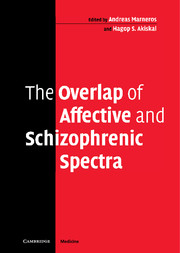Book contents
- Frontmatter
- Contents
- List of contributors
- Preface
- 1 The paradigma of overlapping affective and schizophrenic spectra: schizoaffective conditions
- 2 The overlapping of the spectra: overlapping genes and genetic models
- 3 The continuum of psychosis and its genetic basis
- 4 Functional psychoses: molecular-genetic evidence for a continuum
- 5 State- and trait-related deficits in sustained attention in bipolar disorder: are there any overlaps with schizophrenia?
- 6 The concept of schizoaffective disorder: utility versus validity and reliability – a transcultural perspective
- 7 Phenomenological approaches to the schizoaffective spectrum
- 8 Clinical course of schizoaffective disorders
- 9 Depressive syndromes in schizophrenia
- 10 The overlapping of the spectra: brief and acute psychoses
- 11 Overlapping of the spectra: physical comorbidity between schizophrenia and affective disorders
- 12 The overlapping of the spectra suicide
- 13 Biological treatment of schizoaffective disorders
- 14 Psychological therapies and schizoaffective disorders
- Epilogue: The interface of affective and schizophrenic disorders: a cross between two spectra?
- Index
7 - Phenomenological approaches to the schizoaffective spectrum
Published online by Cambridge University Press: 02 September 2009
- Frontmatter
- Contents
- List of contributors
- Preface
- 1 The paradigma of overlapping affective and schizophrenic spectra: schizoaffective conditions
- 2 The overlapping of the spectra: overlapping genes and genetic models
- 3 The continuum of psychosis and its genetic basis
- 4 Functional psychoses: molecular-genetic evidence for a continuum
- 5 State- and trait-related deficits in sustained attention in bipolar disorder: are there any overlaps with schizophrenia?
- 6 The concept of schizoaffective disorder: utility versus validity and reliability – a transcultural perspective
- 7 Phenomenological approaches to the schizoaffective spectrum
- 8 Clinical course of schizoaffective disorders
- 9 Depressive syndromes in schizophrenia
- 10 The overlapping of the spectra: brief and acute psychoses
- 11 Overlapping of the spectra: physical comorbidity between schizophrenia and affective disorders
- 12 The overlapping of the spectra suicide
- 13 Biological treatment of schizoaffective disorders
- 14 Psychological therapies and schizoaffective disorders
- Epilogue: The interface of affective and schizophrenic disorders: a cross between two spectra?
- Index
Summary
Classification
The coexistence of symptoms that characterize schizophrenia with those that characterize affective disorder poses a number of knotty questions. Schizoaffective disorder is the most enduring of the various labels used for this overlap but the definitions of this term have varied and have identified groups that have not overlapped well (Brockington and Leff, 1979). Most have specified either the presence of schizophrenia-like psychotic features within an affective syndrome, or the occurrence of psychotic features when affective symptoms are quiescent.
Much of the research over the past several decades has employed the definition contained in the Research Diagnostic Criteria (RDC) (Spitzer et al., 1978). In this system the presence within a major depressive or manic syndrome of a Schneiderian first-rank symptom such as a delusion of passivity or thought broadcasting, persistent non-affective hallucinations, or definite instances of formal thought disorder, warrants a diagnosis of schizoaffective disorder. The presence of any clear psychotic feature when affective symptoms are absent also suffices and this defines the mainly schizophrenic subtype of schizoaffective disorder. In contrast, the DSM-IV definition is much narrower and encompasses only those who would meet the RDC for the mainly schizophrenic subtype of schizoaffective disorder.
Competing views
Schizoaffective disorder may be considered in one of three or more ways. According to a dichotomous view, the diagnosis applies to individuals who, in fact, have either schizophrenia or an affective disorder.
- Type
- Chapter
- Information
- The Overlap of Affective and Schizophrenic Spectra , pp. 133 - 144Publisher: Cambridge University PressPrint publication year: 2006

